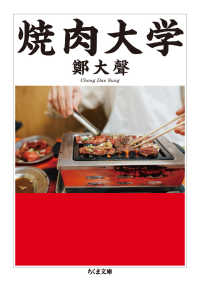- ホーム
- > 洋書
- > 英文書
- > History / World
Full Description
In seventeenth-century Europe, florilegia were lavishly produced picture books that featured hand-drawn or printed illustrations of a wide variety of flowers. Many of the plants depicted in florilegia stemmed from the Americas and Asia and were much desired for cultivation and study in European gardens. By approaching florilegia as material objects, this colourfully illustrated volume offers new insights into how florilegia mirrored different forms of plant knowledge. The volume reconstructs the expertise which gardeners, compilers of florilegia, and image-makers must have possessed in order to cultivate the once-living specimens and immortalise the flowers on paper and parchment.
Contents
Contents
Acknowledgements
Notes
Core Examples
List of Figures
Introduction
1 Picture Books of Colourful Flowers from the Seventeenth Century
2 Towards a History of Knowledge
3 Making Seventeenth-Century Florilegia
4 Overview of Core Examples and This Volume
1 Rare and Curious Flowers in the Seventeenth Century
1 Introduction
2 Balancing a Diversity and Variety of Flowers
3 The Rare and the Curious
4 Conclusion
2 Growing Flowers into Rarities and Curiosities
1 Introduction
2 How to Plant According to Seventeenth-Century Florilegia
3 Cultivating Rare and Curious Flowers through Care and Patience
4 Preparing Earth for a Good Planting Ground
5 A Time to Plant and a Time to Enjoy the Blooms
6 Conclusion
3 Picking Flowers for Every Season through Images and Text
1 Introduction
2 Copying Flowers
3 Excerpting Flowers, Extracting Knowledge
4 Putting Flowers in Seasonal Order
5 Conclusion
4 From Describing Flower Colours to Describing Colouring Flowers
1 Introduction
2 Modifying and Reprinting Seventeenth-Century Florilegia
3 Leafing through a Flower Book
4 Describing Flowers and Their Colours
5 Describing How-to Colour Flowers
6 Conclusion
5 Keeping Flowers between the Pages
1 Introduction
2 Preserving Flowers on Paper and Parchment
3 Losing Rareness and Curiousness
4 Capturing Flowers in the Moment(s)
5 Pressing Flowers for Rare and Curious Features
6 Keeping the Collection as a Whole
7 Conclusion
6 Making Colourful Images of Flowers in Life-Size
1 Introduction
2 Picturing Rare and Curious Flowers
3 Drawing Flowers Life-Size
4 Adding Colours to Flowers
5 Conclusion
Conclusion
1 A Customisable Genre Embracing Different Forms of Knowledge
2 A Time to Make
Appendix 1: Making Colours Series
Appendix 2: Planting Pigments ColLAB
Appendix 3: Hortus floridus Iesse, Or, The Imperfect Book of Flowers: A Twenty-First-Century Florilegium
Bibliography
Index of Names, Works, and Flowers








